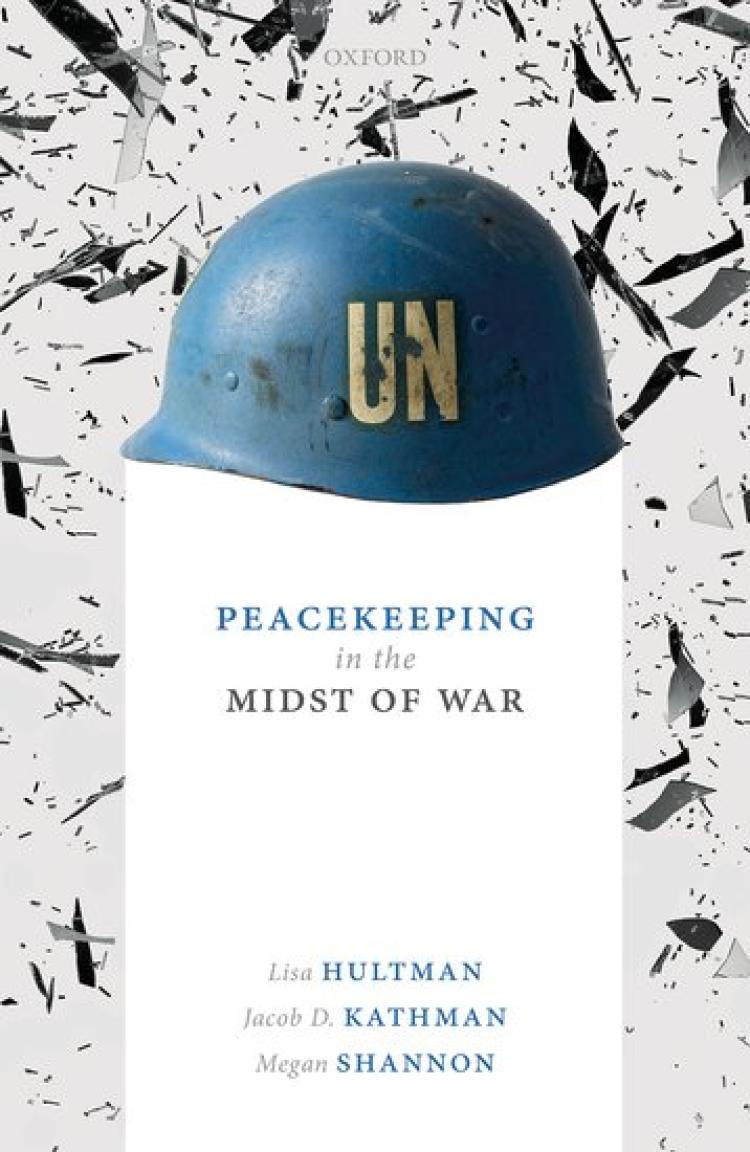Good news: U.N. peacekeepers do, in fact, reduce conflict
Filling a scholarly vacuum, CU Boulder political scientist and co-authors measure the efficacy of peacekeeping missions
For decades, U.N. peacekeeping missions have been dispatched to quell civil wars worldwide, but how well do those missions work?
Despite being the most visible tool of international intervention, scholars and world leaders know relatively little about how well peacekeeping efforts actually work, says Megan Shannon, associate professor of political science at the University of Colorado Boulder.

Megan Shannon
That is why she and co-authors Lisa Hultman and Jacob Kathman teamed up to write Peacekeeping in the Midst of War, which reports that U.N. peacekeepers reduce battlefield violence and violence against civilians in civil wars.
U.N. peacekeeping is an “imperfect but indispensable instrument,” Shannon says, adding that this is worth bearing in mind as the U.S. administration considers cutting funding to support the U.N. peacekeeping budget.
Shannon, who joined the CU Boulder faculty in 2014, recently fielded five questions from Colorado Arts and Sciences Magazine. The questions and her replies follow:
Your CV reveals a deep interest in studying (and facilitating) peace. Can you tell us what drew you to this line of research?
I was drawn to peace research initially as an undergraduate learning about the Arab-Israeli conflicts. I visited the West Bank after I graduated and became even more passionate about finding solutions to the conflict between Israelis and Palestinians.
I went to graduate school and realized that there are numerous intractable conflicts all over the world, that these conflicts share certain patterns, and that conflict can be studied scientifically. I became interested in these learning about these patterns, because I felt understanding the similar processes behind conflicts would better inform our knowledge of how to prevent and resolve conflict.
One of the chapters in Peacekeeping in the Midst of War is focused on measuring the effectiveness of peacekeeping. When you are studying something as chaotic as civil war, how are you able to quantify the effectiveness of efforts to keep peace?
While civil wars are chaotic, there are common indicators of the severity of violence across civil wars. Two such indicators are the number of people killed as a result of civil war battles, and the number of civilians killed as a result of being targeted by insurgent or government forces.
We rely on data gathered by Uppsala University researchers on battlefield violence and violence against civilians. They gather death counts from both types of violence using newspaper and other secondary sources. While these data are not perfect, and deaths are usually under-counted, they are reliable enough to give us a sense of how violence compares across and within civil conflicts.
The underlying message of the book is the same: While the violence that results from civil conflicts may ebb and flow, peacekeeping is an effective mechanism for mitigating the violence."
Your book discusses successes and failures in Cote d’Ivoire and the Democratic Republic of Congo (DRC): Could you share a notable success and an instructive failure?
The book gives more detail on the incidents of success and failure in Cote d'Ivoire and the DRC. However, I want to stress that by detailing these successes and failures, we are more interested in showing how peacekeeping works on the ground than we are in assessing the overall effectiveness of peacekeeping.
The book notes that there will be both successes and failures within any individual U.N. effort. It is inevitable. We assess the effectiveness of the U.N. a bit differently by going beyond each instance of failure and success. We ask: is there less violence in general in civil wars with peacekeeping compared to civil wars without? Is there less violence within the same civil war when more peacekeepers are there than when fewer or no peacekeepers are there? We find the answer to both questions is yes, and that peacekeeping is even more effective when it has greater capacity and more appropriate composition (more troops).
In Cote d'Ivoire, the U.N. mission was at its highest capacity from 2012-17. Yet we see both success and failure during this time period. A failure is when the Nahibly Refugee camp was attacked by individuals aligned with government forces in 2012; at least seven people were killed and 50 wounded.
Yet the U.N. mission guarding the camp was very understaffed, mostly because there was an understanding that the government would be more responsible for security at the camp. So, an instruction from that event is: even if the overall capacity of the U.N. is high, if it is understaffed in insecure areas, violence can still persist. But a few months later, the U.N. mission worked well with government forces when there was an attack by unidentified gunmen on a village in the western part of the country. The joint force was eventually able to provide enough security that civilians felt safe enough to return to their homes. Overall, we find that violence declined during this time period, and that can partially be attributed to the increase in U.N. forces.
In the DRC, there were serious outbreaks of violence in Bunia, Ituri, in 2003. The U.N. was greatly understaffed in that area because the U.N. Security Council was unaware of how quickly the Ugandan forces whom were providing security in the area would withdraw. Violence also erupted around the same time in Bukavu, Kivu. The U.N. ultimately responded by increasing the size of the mission by 50% in 2004. It was then more effective in responding to crises of violence in 2005, particularly through the activities of disarmament and positioning themselves between aggressive forces.

One of the book’s reviewers noted that you and your co-authors “demonstrate that the composition of the peace operation (troops, observers, civilian police) influences outcomes; most previous research ignored this distinction.” How important is the composition of a peace operation, and what can we learn from your research in this area?
Most research on peacekeeping treats all U.N. missions as the same. Previous research rarely distinguishes the number of personnel serving with missions or the type of personnel. Yet as we show in the book, missions can differ greatly from each other, and the same mission can differ from itself over time.
We find that missions with greater numbers of troops and police are associated with less violence against civilians. We also find that missions with greater numbers of troops are associated with less violence on the battlefield. This tells us that to most effectively address violence, mission capacity and composition are important factors to consider.
A Rand Corporation study seems to project that civil wars will decline in the coming decades. Do you share this view?
Our book doesn't necessarily make any predictions about the severity of civil war in the future. The underlying message of the book is the same: While the violence that results from civil conflicts may ebb and flow, peacekeeping is an effective mechanism for mitigating the violence.
I am unable to fully assess the RAND study because I don't know what factors went into the models from where they derived their predictions. Their conclusions about the waning of interstate war are not surprising—we have known that interstate war is on the decline since the end of the Cold War. So, I'll speak to their conclusions about intrastate war. The RAND study only looks at one indicator of violence: the number of states experiencing intrastate war. This is just one way to look at the severity of conflict. Other indicators of conflict include the number of states that intervene in intrastate conflicts; the levels of violence in intrastate conflicts; the number of refugees from conflicts; and the diffusion of conflicts to other states.
If the goal is to make predictions about the severity of civil war, it would be more informative to make predictions across a number of indicators. Let's say that the number of states experiencing civil conflict does decline in the future. This does not necessarily tell us anything about the level of violence in conflicts that are ongoing. We could have fewer countries involved in civil conflict, but the ongoing conflicts could be very bloody.
I think we need to look at a number of indicators of conflict severity before making definitive conclusions about the prevalence of civil war in the future. That said, if I had to make a scientifically informed guess, I would not agree that the severity of civil conflict will decline significantly in the coming years. We have seen increases in a number of factors that provide an environment for civil war: a rise of authoritarianism, increasing repression, and a rise in grievances due to factors like economic inequality and climate change. While civil conflict might decline somewhat, I do not think it will decline to the extent that conflict between countries has.

